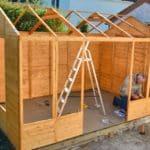Homeowners in Oregon have many good questions about what they can do with their property. One of the reasons people choose to buy a rural property or move to older neighborhoods with larger lots is because they want room for hobbies or work-from-home activities. Adding an external, free-standing building to your property can give you […]
Blog
Urban Growth Boundary Information for Oregon Development
The ability to build a structure or develop a parcel of property is constrained by zoning laws, but it is also limited by a city’s urban growth boundary. In recent years, urban growth boundaries have become scrutinized as more regions suffer housing shortages (and consequently higher home and rent costs). What is the urban growth […]
Considering Opening an Air B&B in Southern Oregon?
Many tourists flock to Southern Oregon every year. Our region is filled with outdoor activities to fulfill many interests, from hiking to skiing and whitewater rafting. With nearly 200 days of sunshine each year, there’s plenty of time for visitors to spend their days enjoying nature. For those preferring something a bit more relaxed, our […]
Do You Need a Permit to Build a Driveway?
It’s commonly known that building a home requires a bevy of permits and approvals, starting with the initial blueprints and down to the last electrical work. However, many new property owners might not be aware that building a driveway also often requires a permit. If you’re purchasing an undeveloped parcel of land, it’s a good […]
Oregon’s Forestland Program
Forestry remains one of the largest industries in Oregon. Our state is the largest softwood lumber producer in the United States. Forests cover nearly 50% of Oregon’s land, and about half of that is managed as national forest zones. Forestland in Oregon is defined by statute and includes 19 western counties: Benton, Clackamas, Clatsop, Columbia, […]
Oregon Land Use Regulations for Wineries
Southern Oregon is home to many wonderful industries, but some of the characteristics that make the land so unique are the climate and fertile soil. Because of those aspects, our lands are full of potential for farming, and one of the fastest growing industries in our area is producing wine. Best of all, land in […]
Land Use Requirements for Marijuana Farming in Oregon
In June 2021, the State of Oregon Employment Department published a report illustrating the growth of the state’s legal marijuana industry. In April 2021, recreational marijuana sales hit a record high (at that time) of $110.5 million–a 23.5% increase as compared to the same month a year earlier. Not surprisingly, harvest productions are also on […]
Basics of Zoning Laws for Small Businesses
Owning a small business is hard work. Not only do you have to manage the day-to-day operation, but you must also be proficient in everything from employment laws to community networking. One area that many business people struggle with is navigating zoning laws. Zoning laws or ordinances are rules within your city or county that […]
Preparing to Testify at a Land Use Hearing
When a significant land use change is requested, the municipal code often requires a hearing where all parties have the opportunity to express their views. For example, one of the goals of Oregon’s statewide land use planning strategy recognizes the importance of citizen involvement “in all phases of the planning process.” Providing testimony at local […]
Lot Line Adjustments in Oregon
Every parcel of land has boundaries or “lot lines” defined by surveyors and recorded within the city or county records. A property owner may want to adjust lot line boundaries for many reasons. Sometimes an owner desires to combine properties into a single parcel or sell a portion of his land to a neighbor. Lot […]










